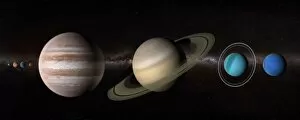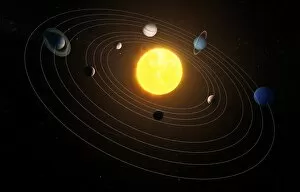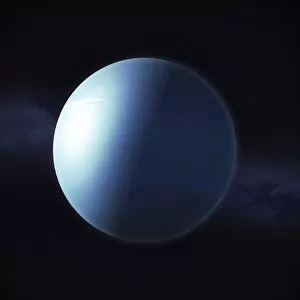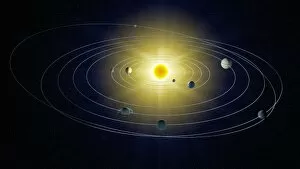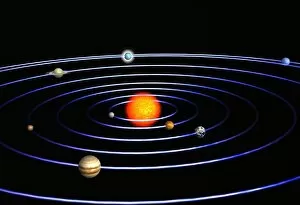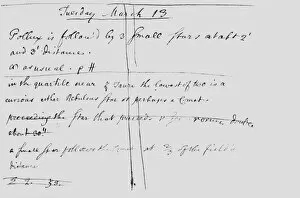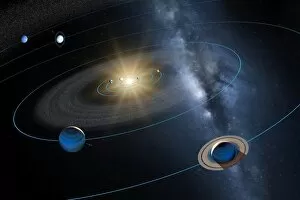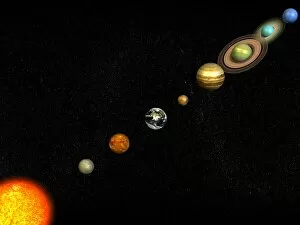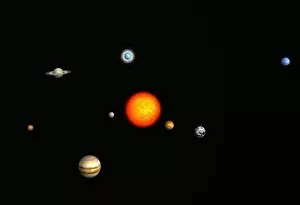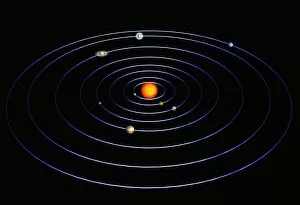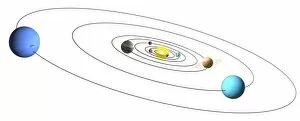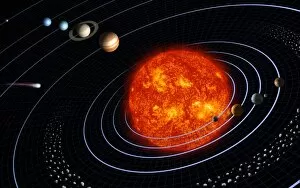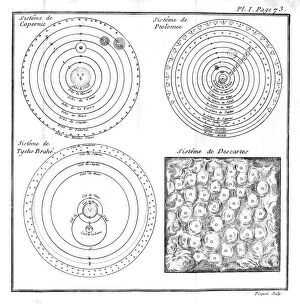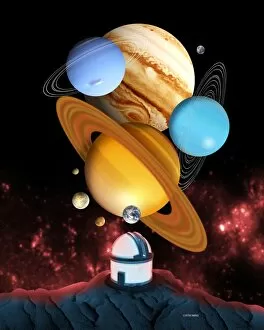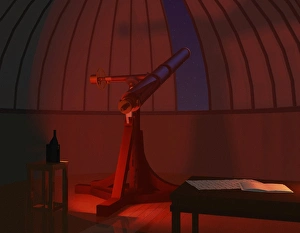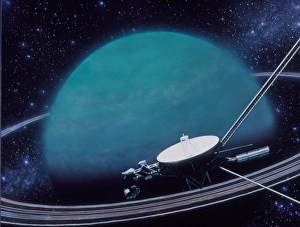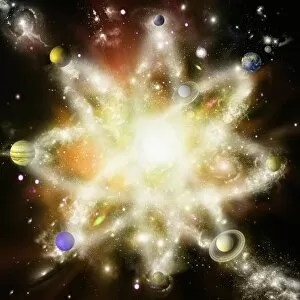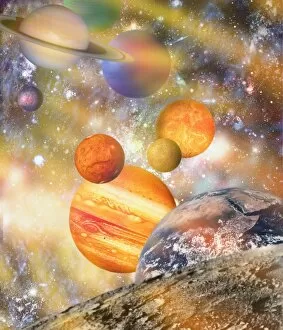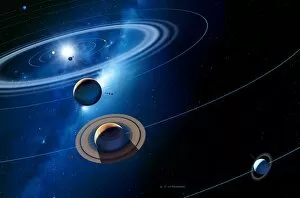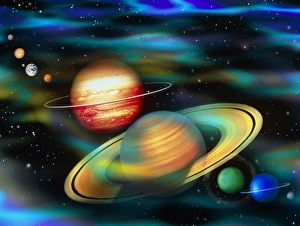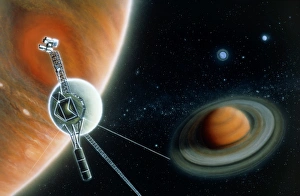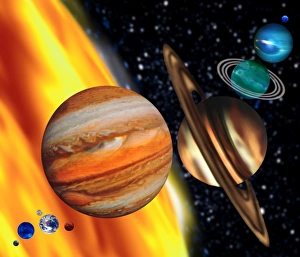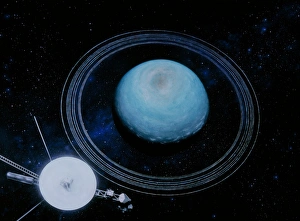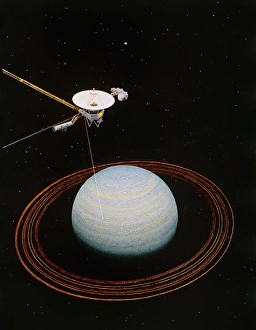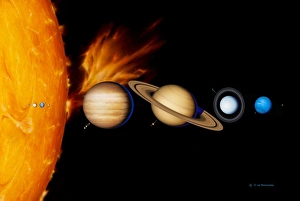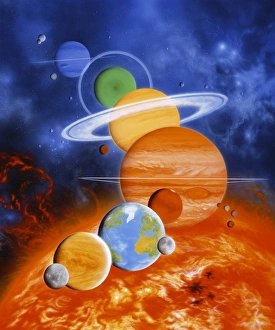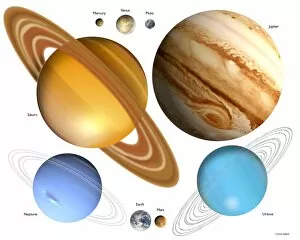Uranus Collection (page 2)
Uranus is the seventh planet from the Sun and the third largest in our Solar System and has a diameter of 51,118 kilometers
154 items
All Professionally Made to Order for Quick Shipping
-
Uranus Collection
Uranus is the seventh planet from the Sun and the third largest in our Solar System and has a diameter of 51,118 kilometers, making it four times wider than Earth, and is composed mostly of hydrogen and helium with traces of methane and water ice. Uranus has 27 known moons, most of which are named after characters from Shakespeare's plays or Alexander Pope's poems. Its unique feature is its extreme tilt on its axis at 97 degrees, which causes its seasons to last for 21 years each. Its atmosphere consists mainly of hydrogen and helium with clouds made up of methane ice crystals that give it a blue-green color, discovered by William Herschel in 1781 and was originally thought to be a star until further observations revealed it to be a planet instead. It takes 84 Earth years for Uranus to complete one orbit around the Sun, making it one of the longest orbits among all planets in our Solar System.
+
Our beautiful pictures are available as Framed Prints, Photos, Wall Art and Photo Gifts
The Uranus collection from Media Storehouse offers a range of high-quality wall art, framed prints, photo prints, canvas prints, jigsaw puzzles and greeting cards featuring stunning images of the seventh planet in our solar system. Our collection includes breathtaking photographs taken by NASA's Voyager 2 spacecraft during its flyby of Uranus in 1986. These images capture the unique features of this ice giant such as its tilted axis and unusual magnetic field. Our collection also features artistic interpretations of Uranus based on scientific data and computer simulations. Whether you are an astronomy enthusiast or simply appreciate beautiful imagery, the Uranus collection has something for everyone. Each piece is printed using state-of-the-art technology to ensure vibrant colors and sharp details that will enhance any space. With so many options available, it's easy to find the perfect addition to your home or office decor with this captivating planetary collection from Media Storehouse.
+
What are Uranus (Planets Space Exploration Science) art prints?
Uranus art prints are high-quality reproductions of images captured by space exploration missions and scientific research of the planet Uranus. These prints showcase the beauty and mystery of this distant gas giant, featuring stunning photographs taken from various angles and distances. We offer a unique perspective on one of the most fascinating planets in our solar system, with its distinctive blue-green coloration, cloud formations, rings, and moons. Uranus art prints are perfect for anyone interested in astronomy or space exploration. They make great additions to home decor or office spaces, adding a touch of wonder and inspiration to any room. Whether you're an amateur astronomer or simply appreciate the beauty of our universe, these prints are sure to captivate your imagination. We offer a wide selection of Uranus art prints that are available in different sizes and formats to suit your preferences. Each print is carefully produced using high-quality materials to ensure durability and longevity so that you can enjoy them for years to come.
+
What Uranus (Planets Space Exploration Science) art prints can I buy from Media Storehouse?
We offer a wide range of Uranus art prints that are perfect for space exploration enthusiasts and science lovers. You can choose from a variety of stunning images captured by NASA's Voyager 2 spacecraft, which flew past the planet in 1986. These include breathtaking shots of Uranus' unique blue-green atmosphere, its rings, and its many moons. In addition to these incredible photographs, Media Storehouse also offers artistic interpretations of Uranus created by talented artists around the world. These pieces showcase the beauty and mystery of this distant planet in different styles and mediums such as digital art, illustrations or paintings. Whether you're looking for a striking image to hang on your wall or an inspiring gift for someone special, we have something for everyone who is fascinated with Uranus and our solar system.
+
How do I buy Uranus (Planets Space Exploration Science) art prints?
To purchase Uranus art prints from Media Storehouse, you can browse our extensive collection of images featuring the planet and select the ones that catch your eye. Once you've found the perfect print, simply add it to your cart and proceed to checkout. You'll be prompted to enter your shipping information and payment details before finalizing your order. We offer a variety of sizes for their prints, so make sure to choose one that fits your space perfectly. We also offer framing options if you prefer a ready-to-hang piece of artwork. Whether you're an astronomy enthusiast or just looking for unique wall decor, Uranus art prints from Media Storehouse are a great choice. With high-quality printing and durable materials, these prints will last for years to come and bring a touch of outer space into your home or office.
+
How much do Uranus (Planets Space Exploration Science) art prints cost?
As a provider of Uranus art prints, we offer a range of options for customers to choose from. The cost of these prints will depend on the size and type of print that you select. Some options include canvas prints, framed prints, and photographic prints. Each option has its own unique features and price point. The prices for Uranus art prints are competitive with other similar providers in the market. However, it is important to note that pricing may vary depending on the specific artwork chosen as well as any customization or personalization requests made by the customer. Media Storehouse strives to provide high-quality Uranus art prints at an affordable price point while also offering a variety of options to meet each customer's individual needs and preferences.
+
How will my Uranus (Planets Space Exploration Science) art prints be delivered to me?
We take great care in delivering your Uranus art prints to you. We use high-quality packaging materials to ensure that your artwork arrives in perfect condition. Your print will be carefully rolled and placed inside a sturdy tube for protection during transit. We work with trusted shipping partners who offer reliable delivery services worldwide. Once your order is dispatched, you will receive a tracking number so that you can monitor the progress of your delivery. Our standard delivery service is fast and efficient, but if you require express or priority shipping options, please contact our customer service team who will be happy to assist you. We are committed to providing exceptional customer service and ensuring that our customers receive their orders promptly and securely. We hope that you enjoy your Uranus art prints as much as we enjoyed creating them.

